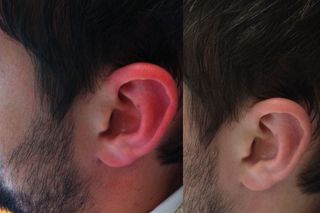Smartphone cameras are surprisingly useful, whether used for quick and dirty snapshots or as impromptu document scanners. Apple claims the eight megapixel camera in its new phone is as good as standalone point-and-shoot pocket cameras and while we wouldn't go that far, it's certainly an improvement over other smartphone cameras.
Apple claims the backside illuminated sensor leads to clearer images in dimly conditions. We did find that lowlight shots, while still grainy, are sharper and clearer than those from other phones but you'll still get better results from a good quality dedicated camera. In brighter conditions, skin tones were captured more accurately than with other phones and, in comparison to the same shot take on the iPhone 4, brightly lit backgrounds weren't blown out.

The higher resolution camera is also capable of recording 1080p high definition video clips which show noticeably more detail than clips recorded on the 720p-capable iPhone 4. In footage taken while rambling along, the automatic image stabilisation worked well at smoothing out the juddering of this writer's ungainly walking. However, since 1080p video clips are quite large and the 4S still lacks a memory card slot, we wish it was possible to opt for lower resolution recording for conserving storage space.
Scream if you wanna go faster
Opening the camera app and snapping multiple shots one after the other is a touch faster than it is on the iPhone 4, which can make all the difference if you're attempting to capture a special, fleeting moment. Although better software coding is undoubtedly responsible, the faster dual core A5 processor almost certainly plays a part too.
Although the 4S has just 512MB of RAM like its predecessor, that didn't hamper its performance in the SunSpider JavaScript benchmark where it scored 2265.1ms which is noticeably faster than the 3423.3ms scored by the Samsung Galaxy S II and the 3549.4ms scored by the iPhone 4.
In everyday use, tasks such as opening apps, rendering complex web pages and switching between apps felt noticeably snappier than the iPhone 4, which is by no means an underpowered phone. Although there are few apps which specifically require the dual core A5 chip found in the 4S, we suspect this will change in the coming months.
